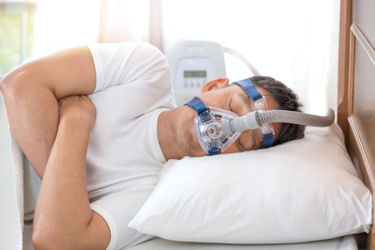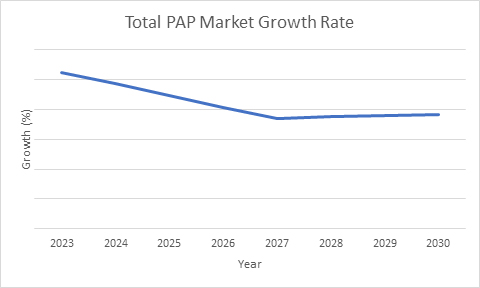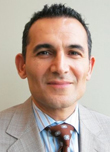Sleep Apnea Market Sees Global Shift From CPAP To APAP Devices
By Graham Diett and Kamran Zamanian, Ph.D., iData Research

Obstructive sleep apnea (OSA) is a respiratory disorder wherein an individual’s airway is obstructed during sleep as muscles relax and the airway walls and tissue collapse. The resulting asphyxia arouses the individual from the deeper stages of sleep so that normal breathing can be restored. It is this disruption of regular sleep rhythms that causes the negative symptoms associated with sleep apnea.
There are three types of sleep apnea cases: OSA, central sleep apnea (CSA), and complex sleep apnea, which is when the apneic events are caused by a combination of OSA and CSA factors. The most common form of sleep apnea is OSA, which accounts for approximately 80% of all sleep apnea cases.1 Obstructive sleep apnea is defined as an interruption in breathing despite respiratory effort from the patient. The patient’s nervous system stimulates the muscles involved in breathing, but a physical obstruction in the airway prevents the airway from opening. In the much less prevalent central sleep apnea, breathing is interrupted by a physiological lack of respiratory effort caused by the central nervous system.
A common treatment for OSA is the use of a positive airway pressure (PAP) machine, which is a flow generator that forces air into the laryngeal cavity via a mask that a patient wears as they sleep. There are three subtypes of PAP devices: continuous positive airway pressure (CPAP), bi-level positive airway pressure (BiPAP), and auto-titrating positive airway pressure (APAP) devices. CPAP devices supply a PAP to a patient at a prescribed rate, as determined during the initial diagnosis. However, the increased pressure in the throat and lungs caused by a CPAP has been shown to cause discomfort in some patients. APAP devices were developed to automatically detect apneic events as they occur and increase the supplied pressure for the duration of the event. After the event has ended, the machine reduces the supplied pressure to a lower, more comfortable level.1 BiPAP devices (also referred to as variable positive airway pressure) are the highest-end flow generators and are able to produce different pressures for inhalation and exhalation, which has been found to alleviate some patients’ discomfort.1
Factors Growing The Sleep Apnea Market
The incidence rate of sleep apnea has been increasing each year and will continue to increase globally due to a few factors. Demographic factors, primarily age and the increase in average body mass, are highly correlated with sleep apnea. The increase in body mass raises the incidence of sleep apnea since fat deposits around the upper airway can obstruct breathing, and people with thicker necks likely have narrower airways.2 Smoking and drinking alcohol are also correlated with sleep apnea.2 As a result, the incidence rate of sleep apnea is increasing each year; however, approximately 85% of OSA cases remain undiagnosed.3 This number is expected to decline, as news stories about the dangers of undiagnosed sleep apnea, along with various government initiatives and targeted advertising from the sleep industry, have been contributing to increased public awareness of the symptoms of sleep apnea. Additionally, better technology has improved patient comfort and, as a result, has spurred growth in the APAP and BiPAP markets.1

Figure 1: Access iData’s U.S. respiratory devices market report to view more granular data.
Factors Preventing Growth In the Sleep Apnea Market
Although the sleep apnea market is growing, it is likely not growing at its full potential. One of the reasons has been supply chain disruptions in recent years. These include shipping delays, transportation constraints, increased energy costs, and labor shortages, among other issues. Additionally, access to raw materials has been more challenging due to the war in Ukraine, as that region of the world contains key elements used in electronic components such as nickel and palladium.4 Another primary factor preventing growth is the backlog in diagnosing sleep conditions. Because a diagnostics test is needed to formally diagnose sleep apnea, and because in-clinic polysomnography (PSG) tests are more accurate than home sleep tests, long waiting lists to get into a sleep lab will slow down the growth rate of the PAP device market.1
Growth Among PAP Devices
Although the sleep apnea market is growing globally, growth among PAP devices varies. CPAP devices are becoming more obsolete each year, as APAP devices are superior and are less than double the average selling price of a CPAP device. Additionally, the increased pressure in the throat and lungs caused by a CPAP device has been shown to cause discomfort in some patients.
APAP devices are the fastest-growing PAP devices due to the benefits they provide over CPAP devices, mainly the ability to detect apneic events and adjust the supplied pressure accordingly. In addition to the market-wide growth factors such as demographic factors and an increasing awareness of sleep apnea, APAP devices also benefit from the advancements in technology, as its increase in patient comfort makes APAP devices more appealing than CPAP devices.
Although BiPAP devices are the highest end, they are growing at a slightly lower rate than APAP devices. BiPAP devices are niche products in many regions in the world and among the emerging markets, CPAP devices are still widely used. However, some patients have found little difference between CPAP and APAP devices, and instead have the best experience with the bi-level option.

Figure 2: Access iData’s U.S. respiratory devices market report to view more granular data.
Conclusion
The overall sleep apnea market is growing at a noticeable rate due to factors such as the aging population, an average increase in body mass, and an increase in sleep apnea awareness. However, the sleep apnea market is likely not growing at its full potential due to external disruptions.
CPAP machines have traditionally been the standard PAP device to treat sleep apnea. However, in recent years, growing awareness of the benefits provided by APAP machines has caused a significant shift away from CPAP devices. This trend is already apparent in mature markets such as North America and Western Europe. CPAP devices are still the most popular device in most emerging markets, but there will be a gradual shift toward APAP devices in the next few years.
References
- iData Research Inc. (2023). EU Market Report Suite for Anesthesia, Respiratory, and Sleep Management Devices - 2023. Vancouver.
- Mayo Clinic. (2023, April 6). Sleep Apnea. Retrieved from mayoclinic.org: https://www.mayoclinic.org/diseases-conditions/sleep-apnea/symptoms-causes/syc-20377631#:~:text=can%20increase%20risk.-,Central%20sleep%20apnea,risk%20of%20central%20
sleep%20apnea - Santilli, M., Manciocchi, E., D'Addazio, G., Di Maria, E., D'Attilio, M., Femminella, B., & Sinjari, B. (2021, September 29). Prevalence of Obstructive Sleep Apnea Syndrome: A Single-Center Retrospective Study. Retrieved from ncbi.nlm.gov: https://www.ncbi.nlm.nih.gov/pmc/articles/PMC8508429/#:~:text=The%20literature%20states
%20that%20the,cases%20remain%20undiagnosed%20%5B37%5D. - OECD. (2022, August 4). The Supply of Critical Raw Materials Endangered by Russia's war on Ukraine. Retrieved from oecd.org: https://www.oecd.org/ukraine-hub/policy-responses/the-supply-of-critical-raw-materials-endangered-by-russia-s-war-on-ukraine-e01ac7be/
 About The Authors:
About The Authors:
Graham Diett is a research analyst at iData Research. He develops and composes syndicated research projects regarding the medical device industry, publishing the U.S. Anesthesia, Respiratory and Sleep Management Device report series.
 Kamran Zamanian, Ph.D., is CEO and founding partner of iData Research. He has spent over 20 years working in the market research industry with a dedication to the study of medical devices used in the health of patients all over the globe.
Kamran Zamanian, Ph.D., is CEO and founding partner of iData Research. He has spent over 20 years working in the market research industry with a dedication to the study of medical devices used in the health of patients all over the globe.
